The Benefits of Collaborative Meeting Planning

Introduction
Collaborative meeting planning is a powerful approach that enables organizations to conduct more effective meetings by involving all stakeholders in the planning process. This ensures that everyone's needs are considered and that everyone is on the same page before the meeting even begins. In this article, we will delve into the numerous benefits of collaborative meeting planning and how it can transform your organization's meetings for the better.
The importance of collaborative meeting planning cannot be overstated. As the business world becomes increasingly competitive, effective meeting planning is crucial for driving productivity, fostering innovation, and ensuring that decisions are made efficiently. Collaborative meeting planning offers a multitude of advantages that can help your organization thrive, from improved meeting outcomes and enhanced team collaboration to increased accountability and efficient use of resources.
Improved Meeting Outcomes
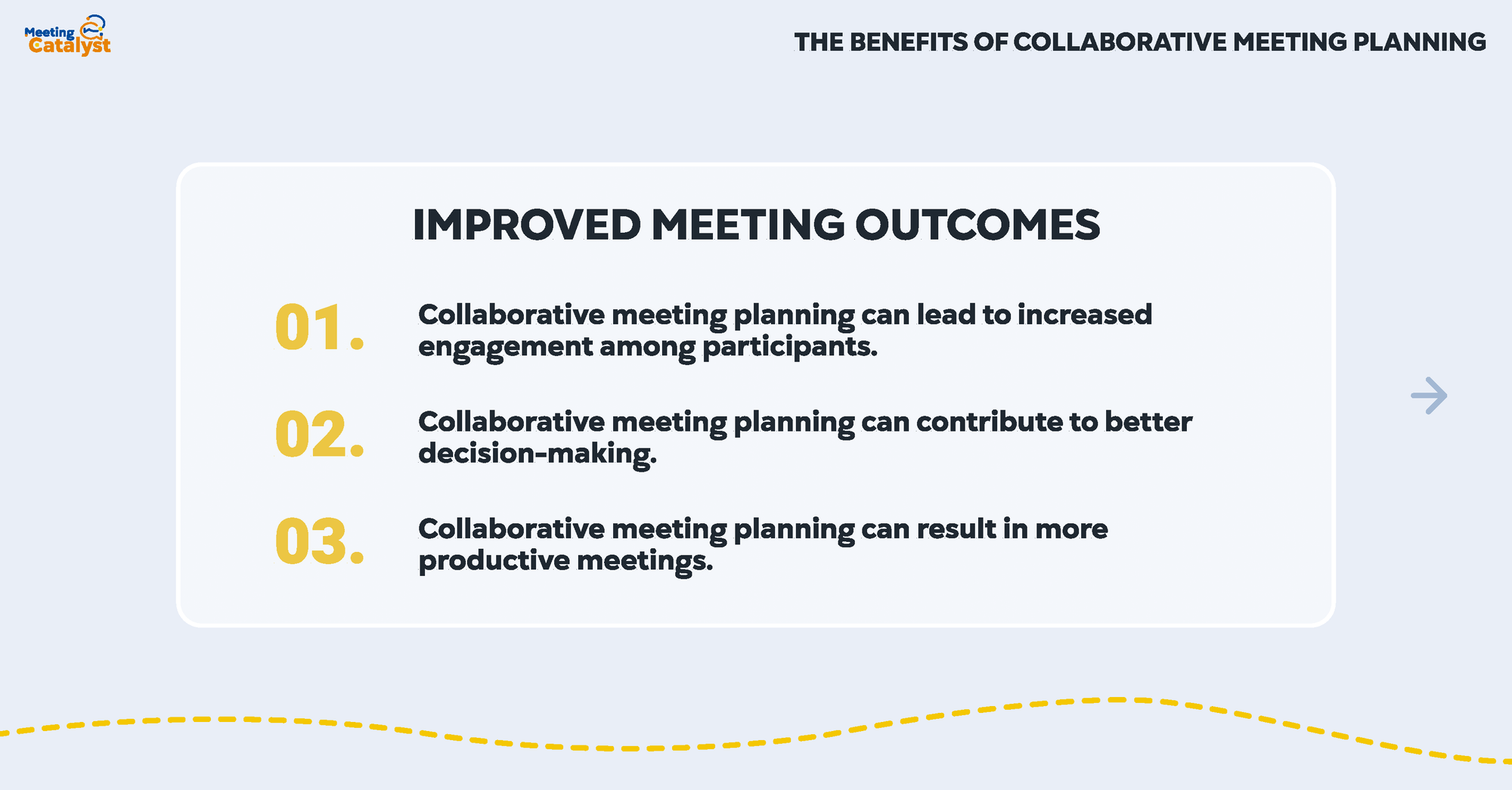
One of the primary benefits of collaborative meeting planning is the improvement in meeting outcomes. By involving all stakeholders in the planning process, you can ensure that everyone's needs are considered, leading to more effective and productive meetings. In this section, we will explore some specific examples of how collaborative meeting planning can enhance meeting outcomes and provide real-life examples of successful implementation.
Firstly, collaborative meeting planning can lead to increased engagement among participants. When stakeholders have a hand in designing the meeting agenda and setting objectives, they are more likely to be invested in the outcome of the meeting. This heightened sense of ownership translates to more active participation, ensuring that all perspectives are considered and valuable insights are shared.
Secondly, collaborative meeting planning can contribute to better decision-making. By involving all relevant stakeholders in the planning process, you can ensure that all necessary information is brought to the table. This comprehensive understanding of the issue at hand allows for more informed decision-making, ultimately leading to better results for your organization.
Lastly, collaborative meeting planning can result in more productive meetings. By having a well-thought-out agenda and clear objectives established in advance, meetings are more likely to stay on track and focused on the task at hand. This minimizes the risk of meetings devolving into unproductive discussions and ensures that valuable time is spent working towards meaningful outcomes.
One real-life example of successful collaborative meeting planning can be found at a technology company that implemented a system where all team members were encouraged to contribute to the meeting agenda. By doing so, the company found that their meetings became more focused, and decisions were made more efficiently. The result was a significant reduction in meeting duration and an increase in overall productivity.
By adopting a collaborative approach to meeting planning, organizations can significantly improve meeting outcomes, leading to increased engagement, better decision-making, and more productive meetings. These improvements can, in turn, contribute to the overall success and growth of your organization.
Enhanced Team Collaboration
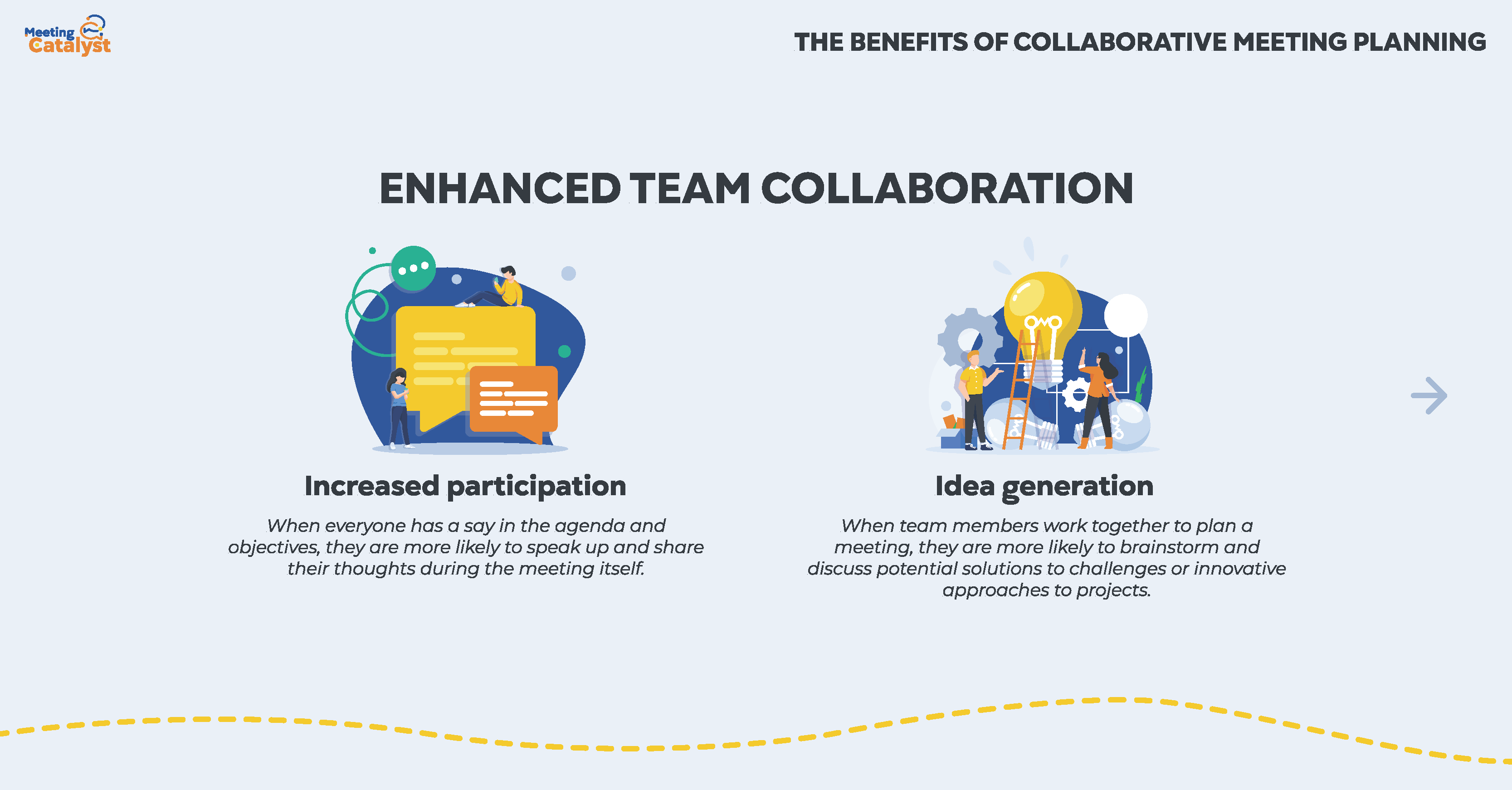
Another significant benefit of collaborative meeting planning is the enhancement of team collaboration. When team members actively participate in the planning process, they are more likely to feel connected to their colleagues and invested in the success of the meeting. In this section, we will discuss specific examples of how collaborative meeting planning can improve team collaboration and provide real-life examples of successful implementation.
Collaborative meeting planning encourages increased participation among team members. When everyone has a say in the agenda and objectives, they are more likely to speak up and share their thoughts during the meeting itself. This open dialogue fosters a sense of camaraderie and ensures that all team members feel heard and valued.
Another way collaborative meeting planning enhances team collaboration is by promoting idea generation. When team members work together to plan a meeting, they are more likely to brainstorm and discuss potential solutions to challenges or innovative approaches to projects. This collaborative problem-solving approach can lead to more creative and effective solutions for your organization.
One real-life example of enhanced team collaboration through collaborative meeting planning is a marketing agency that implemented a system where team members rotated the responsibility of planning and leading meetings. This approach not only encouraged participation from all team members but also helped to develop leadership skills and fostered a stronger sense of teamwork. The result was a more cohesive team, better equipped to tackle complex projects and deliver exceptional results for their clients.
In summary, by embracing collaborative meeting planning, organizations can foster an environment of teamwork and collaboration that leads to increased participation and idea generation among team members. By leveraging the collective knowledge and expertise of your team, you can drive innovation,
Increased Accountability
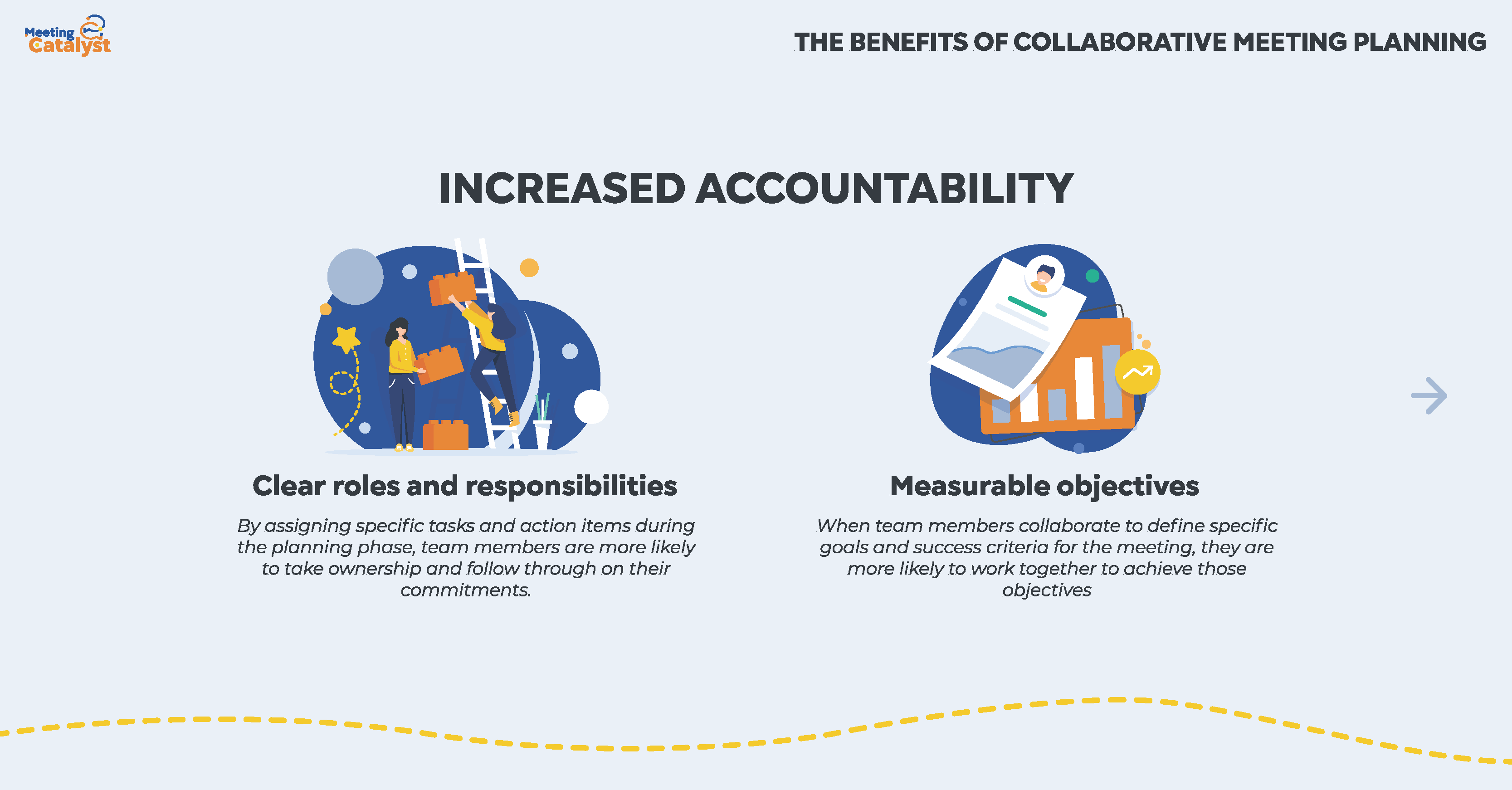
Collaborative meeting planning not only improves meeting outcomes and team collaboration but also fosters increased accountability among team members. When everyone is involved in the planning process, they are more likely to take ownership of their roles and responsibilities during the meeting. This section will delve into specific ways collaborative meeting planning enhances accountability and provide real-life examples of success.
One key aspect of strengthening accountability is establishing clear roles and responsibilities for each team member during the meeting. By assigning specific tasks and action items during the planning phase, team members are more likely to take ownership and follow through on their commitments. This level of responsibility ensures that meetings are more focused, productive, and result-oriented.
Another way collaborative meeting planning boosts accountability is by setting measurable objectives. When team members collaborate to define specific goals and success criteria for the meeting, they are more likely to work together to achieve those objectives. This shared sense of purpose helps to maintain focus, drive progress, and ultimately leads to better meeting outcomes.
A real-life example of increased accountability through collaborative meeting planning comes from a technology company that adopted a shared meeting planning approach. By involving all team members in the creation of meeting agendas and assigning clear action items, they experienced a significant improvement in follow-through and task completion. This resulted in more efficient meetings and a greater sense of ownership among team members.
Collaborative meeting planning is a powerful tool for fostering increased accountability within teams. By involving all team members in the planning process and clearly defining roles, responsibilities, and objectives, organizations can create an environment where everyone is committed to the success of the meeting. This heightened sense of accountability ultimately leads to more productive meetings and better overall outcomes for the organization.
Efficient Use of Resources
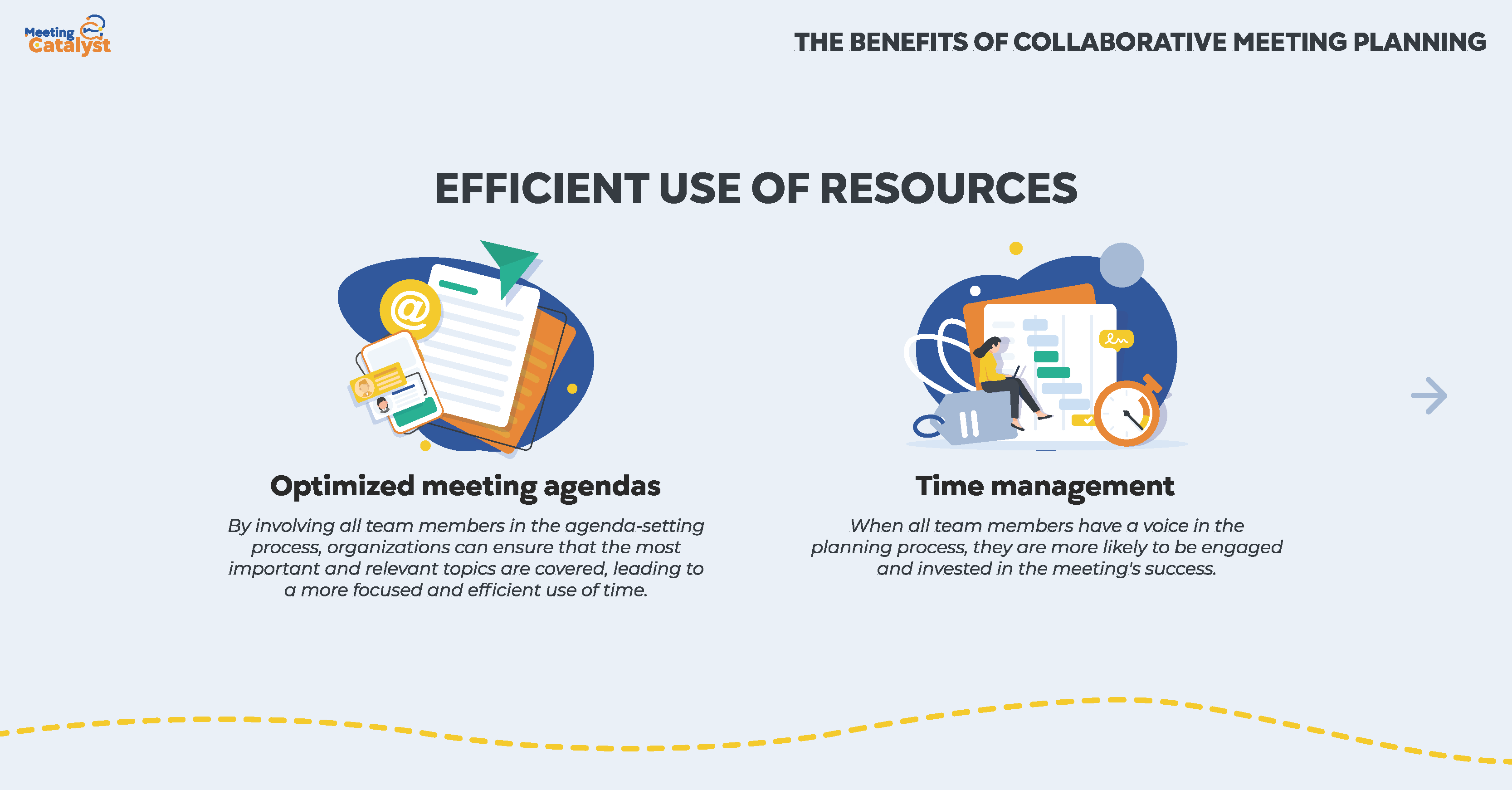
Collaborative meeting planning not only improves meeting outcomes, team collaboration, and accountability but also promotes the efficient use of resources. When team members come together to plan meetings, they can allocate resources more effectively and minimize waste. This section will explore the ways in which collaborative meeting planning can lead to better resource management, as well as provide real-life examples of success.
One of the primary ways collaborative meeting planning contributes to resource optimization is through the creation of optimized meeting agendas. By involving all team members in the agenda-setting process, organizations can ensure that the most important and relevant topics are covered, leading to a more focused and efficient use of time. This collaborative approach reduces the likelihood of unnecessary or irrelevant discussions, allowing for a more streamlined and productive meeting experience.
Another benefit of collaborative meeting planning is the improvement of time management during meetings. When all team members have a voice in the planning process, they are more likely to be engaged and invested in the meeting's success. This increased engagement can lead to more efficient use of time, as team members are more likely to stay on track, adhere to time limits, and avoid going off on tangents.
A real-life example of efficient resource use through collaborative meeting planning comes from a marketing agency that implemented a shared planning approach for their team meetings. By involving all team members in the agenda-setting process and assigning specific time limits for each discussion point, they were able to significantly reduce meeting durations and focus on high-priority tasks. This resulted in more efficient use of time and resources, ultimately leading to better project outcomes and improved team performance.
Collaborative meeting planning is a powerful tool for enhancing resource efficiency within organizations. By working together to create optimized meeting agendas and manage time effectively, teams can minimize waste and make the most of their available resources. The end result is more productive meetings, better overall outcomes, and a healthier bottom line for the organization.
Best Practices for Collaborative Meeting Planning
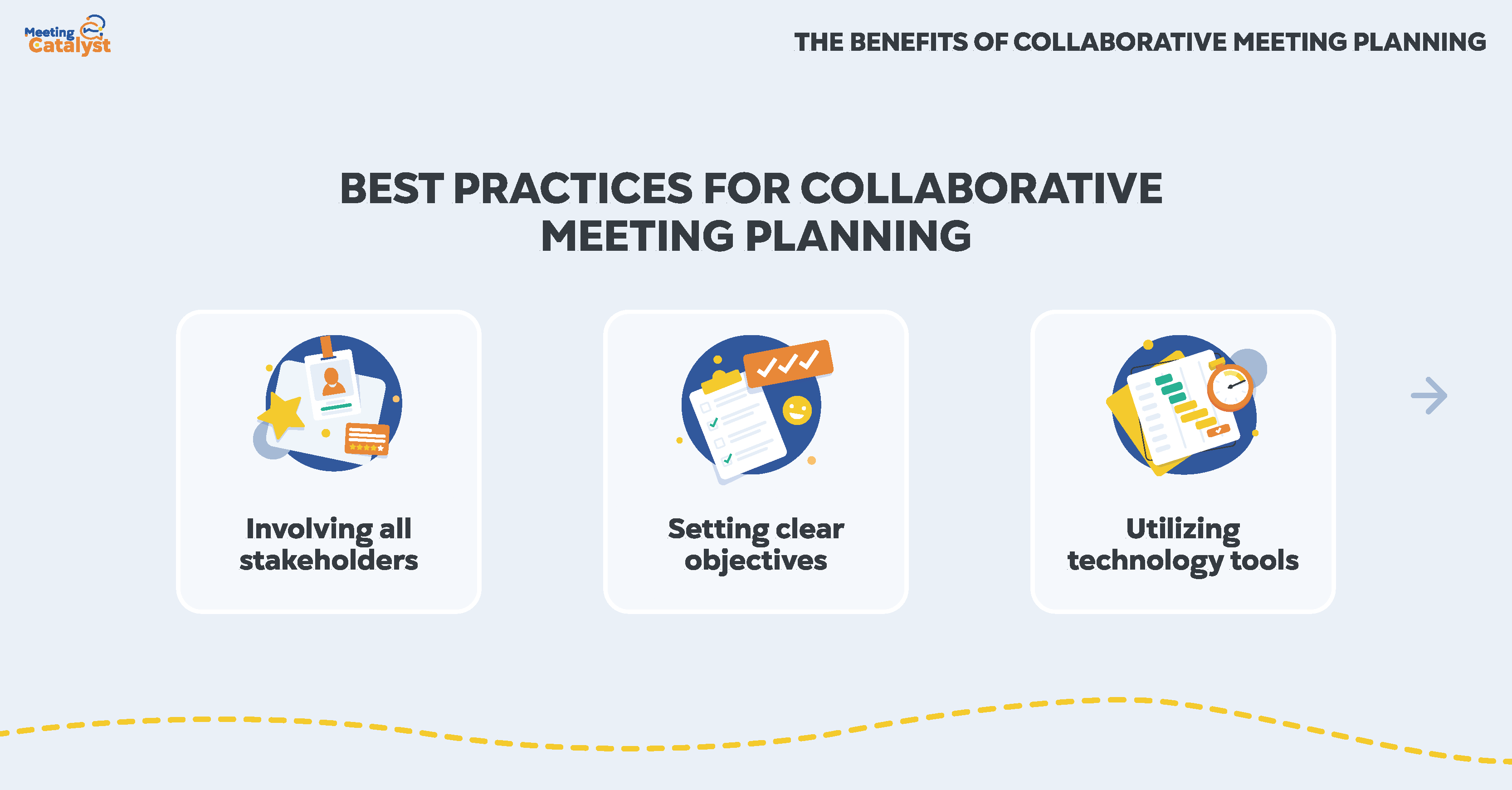
In order to fully reap the benefits of collaborative meeting planning, it's crucial to implement best practices that promote an inclusive, organized, and efficient planning process. This section will outline several key best practices, including involving all stakeholders, setting clear objectives, and utilizing technology tools, along with specific tips and strategies for putting them into action.
Involving all stakeholders in the planning process is essential to fostering an atmosphere of collaboration and ensuring that all perspectives are considered. This means including not only team leaders and managers but also individual contributors and any other relevant parties. By giving everyone a voice, organizations can create a more comprehensive and effective meeting plan.
Setting clear objectives is another important aspect of collaborative meeting planning. Before each meeting, the team should work together to establish well-defined goals and desired outcomes for the session. This helps to create a sense of purpose and keeps everyone focused on achieving the intended results.
Utilizing technology tools can greatly enhance the collaborative meeting planning process. There is a wide array of software and applications available, such as project management platforms, virtual meeting tools, and note-taking applications, which can streamline planning, improve communication, and promote effective collaboration. By integrating these tools into the planning process, organizations can create a more efficient and organized approach to meeting management.
To successfully implement these best practices, consider the following tips and strategies:
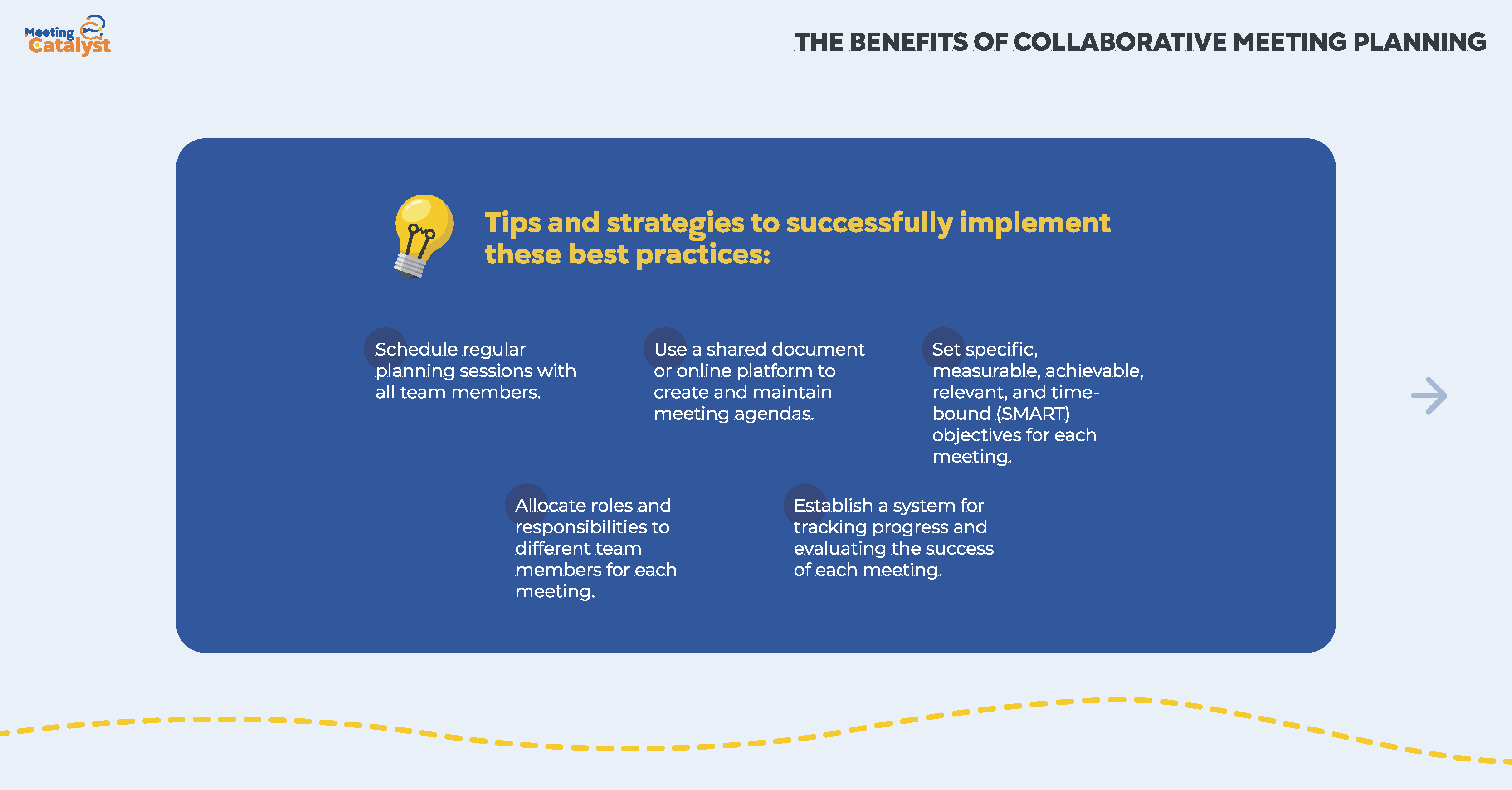
- Schedule regular planning sessions with all team members to ensure everyone is involved in the process and can contribute their ideas and perspectives.
- Use a shared document or online platform to create and maintain meeting agendas, allowing all team members to add, edit, and review the plan in real-time.
- Set specific, measurable, achievable, relevant, and time-bound (SMART) objectives for each meeting to ensure the goals are clear and attainable.
- Allocate roles and responsibilities to different team members for each meeting, such as facilitator, note-taker, or timekeeper, to promote accountability and encourage active participation.
- Establish a system for tracking progress and evaluating the success of each meeting, helping the team to identify areas for improvement and refine their planning process over time.
Challenges and Solutions for Collaborative Meeting Planning
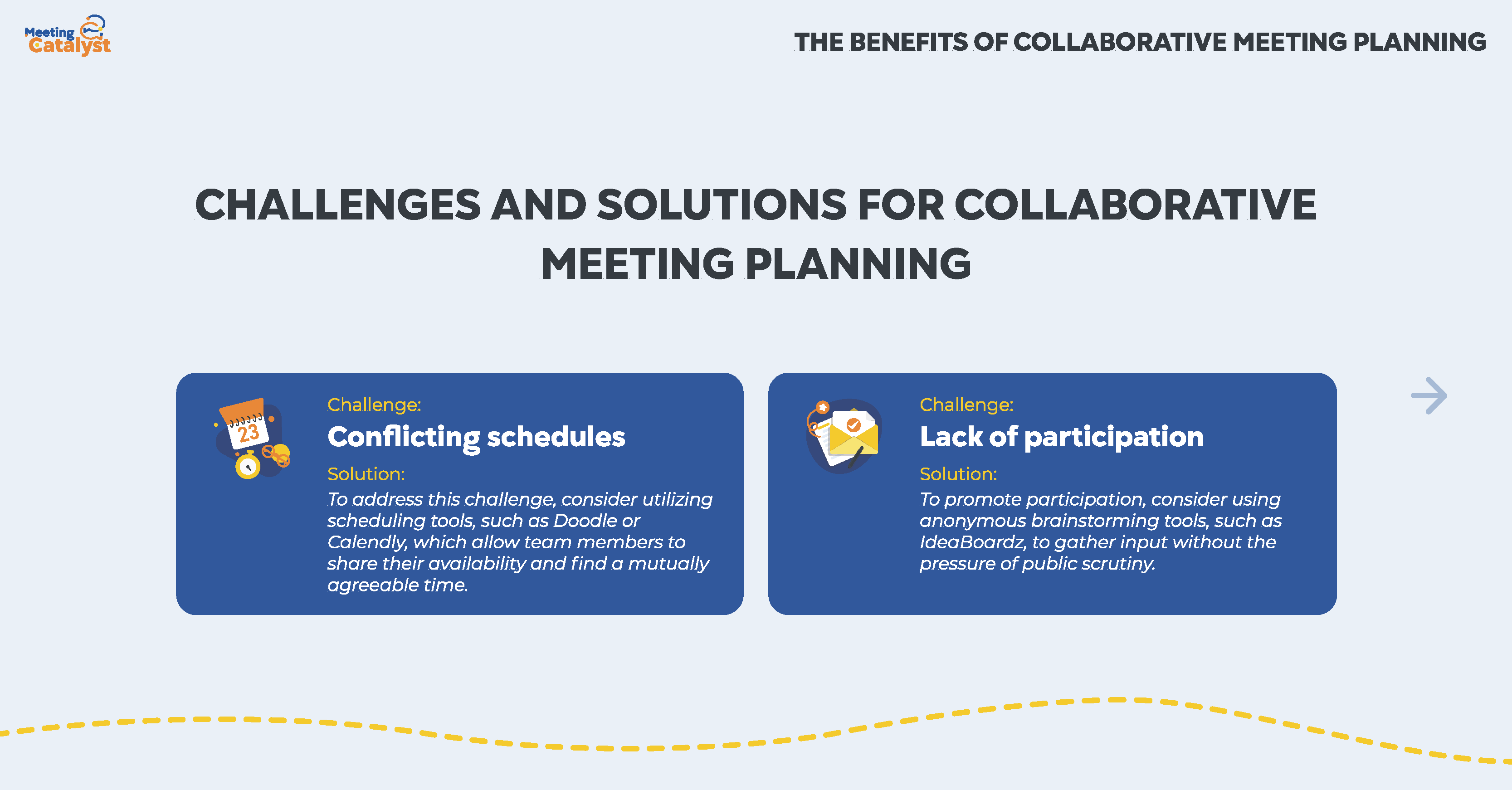
While collaborative meeting planning offers numerous benefits, there are also several challenges that organizations may encounter. This section will outline some common challenges, along with solutions and strategies for addressing them effectively.
Conflicting schedules can make it difficult to find a time that works for everyone involved in the planning process. To address this challenge, consider utilizing scheduling tools, such as Doodle or Calendly, which allow team members to share their availability and find a mutually agreeable time. Additionally, consider holding planning sessions during regular working hours to minimize conflicts with personal commitments.
Lack of participation is another challenge that may arise in collaborative meeting planning. Encouraging active involvement from all team members is key to creating a comprehensive and effective plan. To promote participation, establish a culture of openness and trust where everyone feels comfortable sharing their ideas and opinions. Consider using anonymous brainstorming tools, such as IdeaBoardz, to gather input without the pressure of public scrutiny.
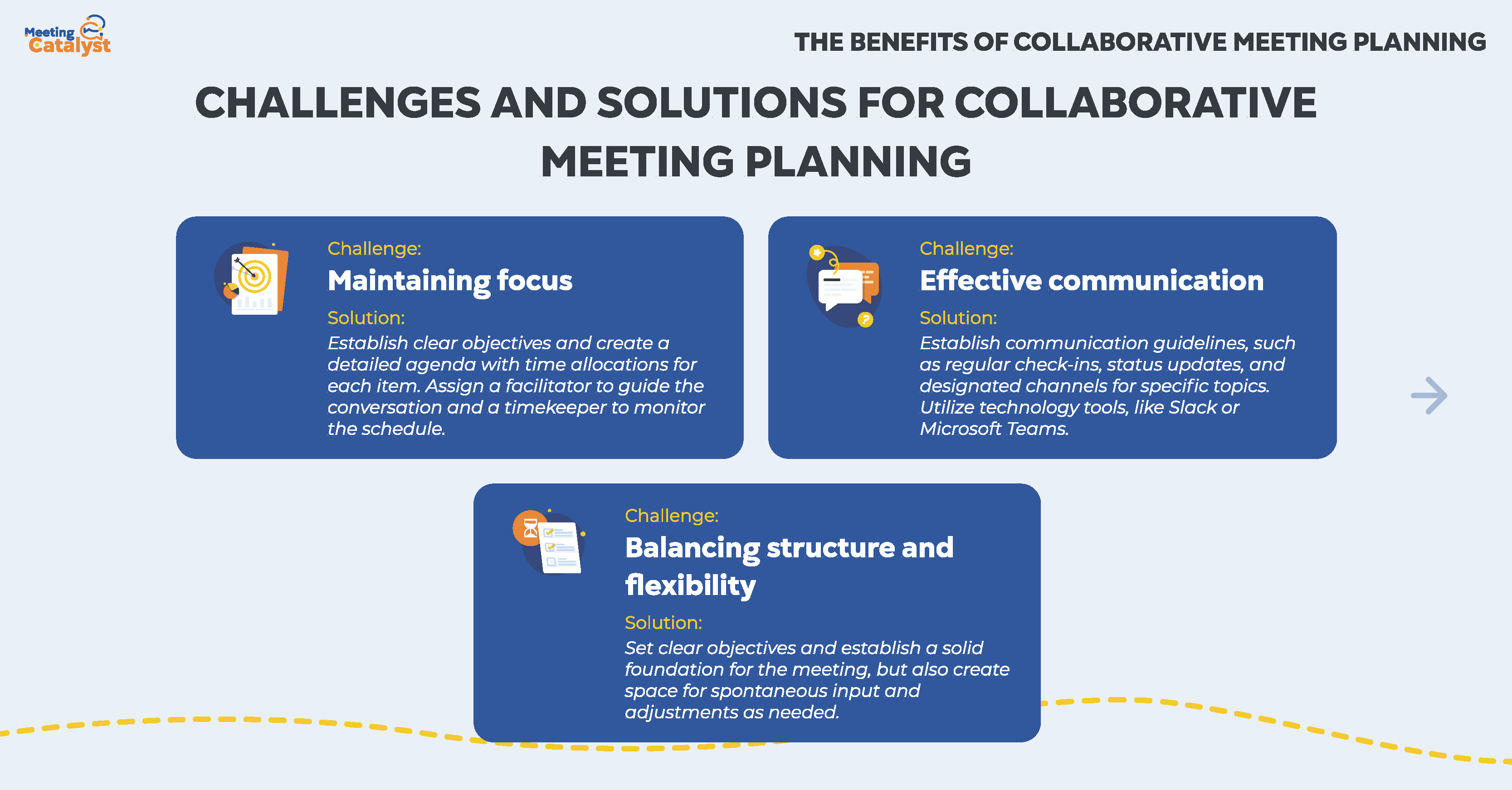
Maintaining focus during meetings is crucial to achieving the desired outcomes. To ensure meetings stay on track, establish clear objectives and create a detailed agenda with time allocations for each item. Assign a facilitator to guide the conversation and a timekeeper to monitor the schedule. Encourage team members to be mindful of time constraints and prioritize the most important topics.
Effective communication is essential to successful collaborative meeting planning. To promote clear, concise, and timely information sharing, establish communication guidelines, such as regular check-ins, status updates, and designated channels for specific topics. Utilize technology tools, like Slack or Microsoft Teams, to facilitate communication and collaboration among team members.
Balancing structure and flexibility is an important aspect of collaborative meeting planning. While a well-organized plan is essential, it's also important to remain adaptable to changing circumstances and new information. To strike the right balance, set clear objectives and establish a solid foundation for the meeting, but also create space for spontaneous input and adjustments as needed.
By acknowledging and addressing these challenges, organizations can continue to benefit from collaborative meeting planning, fostering an environment of increased efficiency, better decision-making, and improved meeting outcomes.
Conclusion
In summary, collaborative meeting planning offers a range of benefits that can significantly improve the quality and effectiveness of meetings within an organization. By involving all stakeholders in the planning process, organizations can achieve:
- Improved meeting outcomes, leading to increased engagement, better decision-making, and more productive meetings.
- Enhanced team collaboration, promoting active participation and idea generation from all team members.
- Increased accountability, ensuring clear roles, responsibilities, and measurable objectives are established.
- Efficient use of resources, optimizing meeting agendas and better utilizing time and other resources.
However, it is essential to recognize the challenges that may arise during collaborative meeting planning, such as conflicting schedules, lack of participation, maintaining focus, effective communication, and balancing structure with flexibility. By implementing best practices and utilizing technology tools, organizations can address these challenges and continue to reap the rewards of collaborative meeting planning.
In conclusion, adopting collaborative meeting planning strategies can lead to more effective and productive meetings, ultimately benefiting both the organization and its team members. By promoting a culture of openness, trust, and collaboration, business and team leaders can facilitate better decision-making, increased accountability, and efficient use of resources, paving the way for a more successful and cohesive work environment.